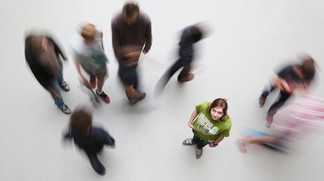Oct 9 2013
For her semester project, a Master’s student in Communication Systems applied a different approach to tracking the flow of the crowds at the Paléo music festival – using cell phone data and statistics.
 © 2013 EPFL - Herzog
© 2013 EPFL - Herzog
Tracking individuals in a large group, be they ants or humans, is no trivial task. By applying statistics to mobile phone signals picked up in a large crowd, Master’s student Elisaveta Kondratieva developed a way to more accurately follow and understand the behavior of the individuals that make up the crowd, revealing the potential and the pitfalls of this new approach. For her semester project, she evaluated an extensive dataset gathered at the 2010 Paléo music festival in a campaign entirely planned and carried out by researchers in the research groups of Patrick Thiran and Martin Vetterli in collaboration with Olivier Dousse at Nokia.
Every year, the Paléo music festival attracts well over 40,000 music aficionados per day. Many carry mobile phones with activated bluetooth devices. In 2010, ten “agents” were part of the crowd, equipped with special mobile phones programmed to pick up and store the identity of all detectable bluetooth devices in their vicinity. The data they gathered provides a list of all of the detectable bluetooth devices surrounding each of the walking agents at any given time throughout the evening.
Often, these data are not enough to discriminate between different nearby locations. Were the detected individuals at the Asian food stall, the stand right next to it, or were they on the way to their next concert? Detecting the presence of bluetooth signals narrows down the position of the mobile phone that emits it, and that of its owner, to a radius around 10 to 20 meters around the agent. The inaccuracy of the agent’s GPS adds up to 10 more meters of uncertainty. Furthermore, many devices were only detected a handful of times in the course of the evening.
This is where statistics come in handy. “Using an approach based on Bayesian statistics, that is by taking into account certain pieces of available information, the accuracy of the outcome can be improved,” she says. Concert schedules, a detailed map of the festival grounds, and other sources of information can help fill in the gaps between separate detections and provide likely estimates of the exact locations of the individuals.
For such an approach to work, a significant fraction of the audience have to have their bluetooth devices set to be detectable. Fortunately, this turned out to be the case: fixed detectors at the entrance to the festival detected over 3,300 devices - just over 8% of the 40,500 people that attended the festival that day.
The quality of the results depends largely on how effectively the agents fan out across the festival grounds. “Two of our agents basically spent the entire evening at the festival together,” says the student, “so the data they obtained overlapped. Also, none of our agents ever went to one of the more remote stages.” To fix these loopholes, future campaigns could involve a larger number of fixed detectors and mobile agents. Additionally, a similar approach could be adopted to follow individuals using their WiFi signals.